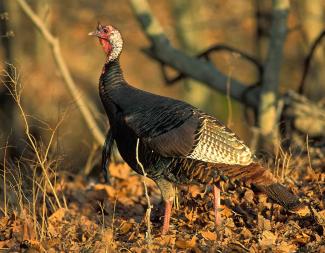Having the right provisions on your land is a deciding factor for wildlife potential. The sections below provide instruction for improving turkey numbers on your property.
Food and Water
Turkeys require direct access to water throughout the year. Construction of one small pond per square mile (one per quarter section is ideal) will improve turkey habitat and provides additional nesting sites.
- Your pond should at least be able to provide water during the driest part of the summer.
- A good size pond to construct is approximately 30 to 40 feet across and 8 feet in depth.
Turkeys are diverse eaters and will adjust their intake based on what is in season. Before you plant, check our Turkey Management page to decide which plant varieties work best for establishing turkey habitat on your property.
Food Plots
While food plots are not essential to turkey habitat, these reserves will help during acute shortages of natural forage.
Winter wheat is one of the best crops for both ease of establishment and use by turkeys. Forest clearings of at least one acre, when planted to wheat in August or September, will provide green wheat all winter. Most turkeys use winter wheat in early spring just before hens begin to lay. Hens and poults will use the grain all summer.
Corn and beans are equally attractive options for turkeys during low-growth periods of winter and early spring. Leaving a few rows standing ensures a food supply in case of deep snow. A portion of the crops left should be knocked down for better use by turkeys.
Plots at Forest Openings
Seed in the fall with one-half bushel per acre of wheat and 2 pounds per acre of orchard grass, applying recommended amounts of limestone, rock phosphate, and fertilizer. Then overseed half of the plot in the fall or winter with 2 pounds per acre each of Ladino clover and red clover, seeding the other half of the plot with 10 pounds per acre of Korean or Summit lespedeza.
These plantings should provide attractive, nutritious food for turkeys, deer and other wildlife for three to five years without further treatment.
- Turkeys prefer thin stands of vegetation and may not use dense, lush stands.
- Apply no more than 20 pounds per acre of nitrogen plant food to avoid excessive vegetative growth.
Range and Seasonal Habitat
Compared to winter range, the space used by turkeys during summer and fall is relatively smaller. Acreage in openings may vary but should comprise between 10 and 30 percent of the annual range.
As colder weather arrives, turkeys become increasingly dependent upon wooded areas for both food and cover from the winter elements. They rely increasingly on acorns, pine nuts, and other mast, and less on winter-prone vegetation.
Woodlands Management
To provide a dependable source of woodland forage for turkeys, landowners should strive for an equal distribution of age and size classes of trees on their timbered lands. Or, try to manage woodlands so approximately one-third of a timbered tract is in small trees, one-third in pole-sized trees, and one-third in mature sawlogs. This ensures a dependable mast crop.






















